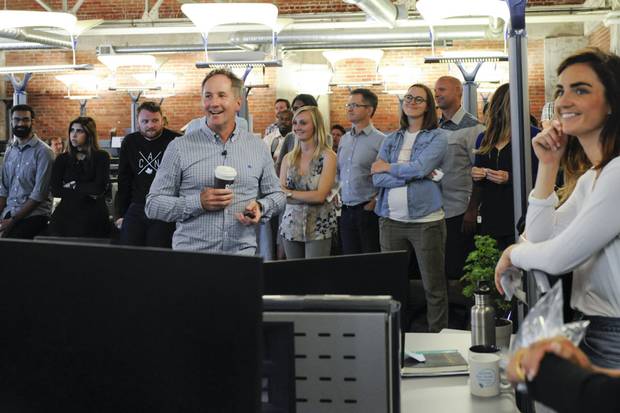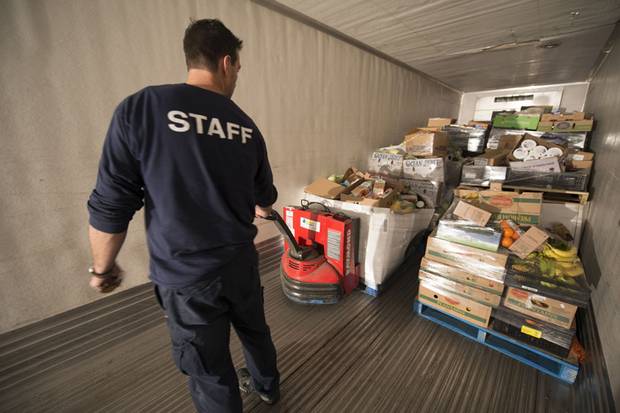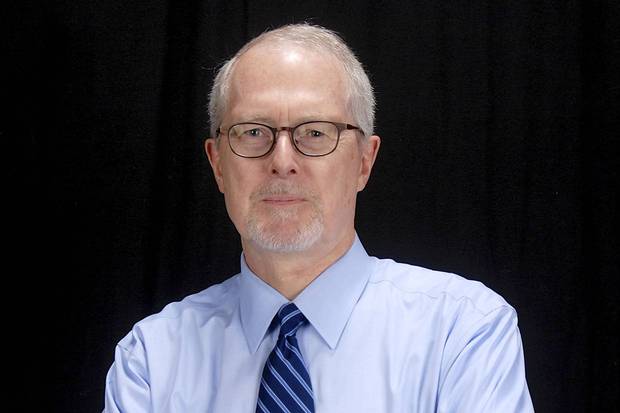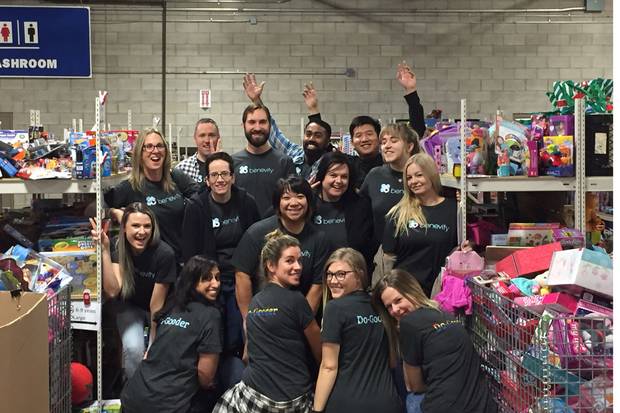In 2018, saying "I gave at the office" is becoming different than it was 10 years ago.
Corporate giving programs, in which employees raise funds or contribute to charities, are changing in the digital age.
Related: How companies use giving to create social and business benefits
Also read: Canoe museum and other small charities paddle harder for donations
While there are still plenty of conventional and successful campaigns, such as for the United Way, across corporate Canada, many companies and their employees are looking for new ways to encourage contributions to good causes.

Bryan de Lottinville, centre front, founder and chief executive officer of Benevity, Inc.
Benevity
"A lot of the trends have to do with the changing roles of companies, how they perceive themselves and perhaps more importantly, how consumers and prospective employees perceive the roles of corporations," says Bryan de Lottinville, founder and chief executive officer of Benevity, Inc.
Founded in Calgary in 2008 and with offices in Toronto and Victoria, Benevity provides companies with a digital platform to help organize and manage employee giving. Benevity's technology lets employees track donations and volunteer hours, as well as providing the companies they work for the tools to match their contributions.
The trend toward online giving and tracking donations is helpful to charities that receive Canadians' donations. It makes it easier to process and keep track of contributions, as well as to know whom to contact for upcoming campaigns through e-mail and social media.
"It means that we can have active and visible communication with our donors year round, across digital channels," says Tania Little, director of development and partnerships for Food Banks Canada, the umbrella organization for Canada's 550 food banks and about 3,000 related food programs.
"Technology also lets us run digital strategy campaigns so that thought leaders in companies know who we are, who we work with and can see the success and impact of our work," Ms. Little says.
"We're like any business. We use a sales process – lead generations, introductions to prospects through businesses we're working with already, looking for new partners where we think we might have shared values."

Founded in Calgary in 2008 and with offices in Toronto and Victoria, Benevity provides companies with a digital platform to help organize and manage employee giving.
Benevity
Many companies, both large and smaller, leverage their employees' volunteer spirit.
For example, Microsoft Canada matches its employees' donations and also contributes for every hour individual employees volunteer. Mastermind Toys, with 60 stores across Canada, sells products to support the We Day organization, and its co-founder Jon Levy accompanied employees on a volunteer trip to Africa, where the company's contributions have helped build classrooms.
Targeted giving is popular. In 2014, for example, Google Canada announced a $1.5-million grant to support a program called Codemakers, with the goal of introducing 100,000 Canadian children and youths to computer coding.
Tapping into corporate donations often requires different strategies than seeking contributions from individual Canadians. It's a perpetual challenge to reach both, though – according to The Giving Report, prepared by Canada Helps (the online giving program for individuals), Canadians donated $9.1-billion to charities in 2015 (the most recent year for which statistics are available).
"While this sounds like great news for the charitable sector, these numbers do not account for inflation," the report says.
"By taking inflation into account … we see that the overall value of charitable donations in Canada has not been able to reach the levels prior to the 2008-2009 recession, remaining relatively flat since 2010."

The trend toward online giving and tracking donations is helpful to charities such as Food Banks Canada, the umbrella organization for Canada’s food banks and related food programs. Technology makes it easier to process and keep track of contributions, as well as to communicate with donors.
Food Banks Canada
Canada's corporate sector picks up some of the slack, but not all.
"Companies want focused, impactful, strategic programs which, ideally, are aligned either with their brand, or of increasing importance, with their people and what they're interested in already," Mr. de Lottinville says.
"We call it the power of 'and' – engaging employees and turning them into proud brand ambassadors."
"The current trend is for corporate giving campaigns to move beyond a simple dedication of dollars per year to a charity of choice," says Alison Grenier, head of culture and research for Great Place to Work Canada, a company that certifies workplace practices for businesses.
"Employees increasingly want to feel part of something bigger than just the walls within which they work. They want to feel proud of their company and feel that the work they do contributes to the betterment of society," she says.
Citing the Canada Survey of Business Contributions to Community, Ms. Grenier wrote in a blog earlier this year that Canadian corporations give more than $3-billion to charities a year, roughly a third of the total contributions by Canadians.

Lou Odette heads his family’s P. and L. Odette Charitable Foundation, which focuses on addressing homelessness and food security.
P. and L. Odette Charitable Foundation
"The survey found that … 50 per of corporations contribute because it builds healthy and strong communities and that is good for business … 48 per cent of corporations are motivated to give because it fits with their values and culture … [and] 45 per cent give back because they believe it is the right thing to do," Ms. Grenier said.
Even as technology advances in the charitable sector, it's still a constant challenge helping charities take advantage.
"We're not interested in charities where you give a bunch of money and get your name on a building," says Lou Odette, who heads his family's P. and L. Odette Charitable Foundation, which focuses on addressing homelessness and food security.
Mr. Odette says he works with a select group of charities; his foundation donated $4-million last year and concentrated "on helping them better deliver on their charitable purpose.
Mr. de Lottinville agrees that one of the big challenges ahead is educating the charities themselves on how to get the most out of their contributions.
"The successful charities have innovative cultures and embrace technology. But we still spend tons of time trying to get charities to accept donations electronically rather than cheques in the mail," he says.
"It's hard work."
